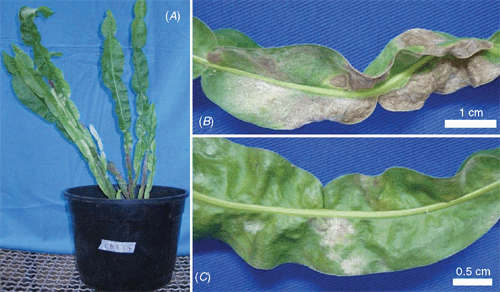First report of Oidium baccharidis on Baccharis trimera in Brazil
D. D. Rosa A B , M. A. Andrião A and E. L. Furtado AA São Paulo State University – UNESP, College of Agronomic Science – FCA, Department of Plant Production – Plant-Health Protection Sector, PO Box 237, 18610-307 Botucatu – SP, Brazil.
B Corresponding author. Email: ddrosa@gmail.com
Australasian Plant Disease Notes 5(1) 73-74 https://doi.org/10.1071/DN10026
Submitted: 20 July 2009 Accepted: 17 June 2010 Published: 12 July 2010
Abstract
Powdery mildew disease was observed on Baccharis trimera in Brazil in January, 2009. Based on the morphological characters, the pathogen was identified as an Oidium baccharidis. This is the first report of this fungus causing powdery mildew on Baccharis in Brazil.
Baccharis (Asteraceae) is represented by more than 500 species distributed mainly in the tropical areas of South America (Joly 1967). Baccharis trimera (Less.) DC., commonly known as ‘Carqueja’, is an herbaceous perennial found throughout South America, including Brazil. B. trimera is one of the 10 most commercialised medicinal plants in Brazil. (Silva Júnior 1997) Where it is used extensively in folk medicine in the treatment or prevention of anaemia, inflammations, diabetes and stomach, liver and prostate diseases (Mors et al. 2000; Verdi et al. 2005). B. trimera is indiscriminately harvested and is included on the list of endangered species (Vieira and Silva 2002). It is also cultivated and has become a commercial crop.
During January 2009, in Araraquara City (21°48′51.4″S and 48°12′5.1″W), São Paulo State, plants and leaves of 4-month-old B. trimera var. CPQBA-1 (healthy plant exsiccate n. 1286, deposited at CPQBA-UNICAMP Herbarium: Campinas University, Campinas, Brazil), were found to be heavily infected by powdery mildew. A specimen of the diseased plant was deposited in the Phytopathological Herbarium of the São Paulo State University (number 718/2009). Disease symptoms included chlorosis and white, powdery growth on leaves and stem of plants (Fig. 1). Samples were sent to the Phytopathological Clinic, Department of Plant Production – Plant-Health Protection Sector, Agronomical Sciences College, São Paulo State University – UNESP, Botucatu, São Paulo, Brazil, for analysis.

|
A morphological description of the fungus follows. Hyphae were up to 4.5–6.5 μm wide with lobed appressoria (6–9 μm diam.), in pairs, opposite each other. Mycelium was amphigenous, evanescent, with multilobed appresoria opposite in pairs. Hyphae were flexuous, light brown. Conidiophores were formed with foot-cell barrel-shape, followed by two short cells, 21.5–22.5 × 8.0–10.0 µm. Conidia were formed in chains, dolliform, 22.5–25 × 8.5–10.5 µm, without conspicuous fibrosin bodies. The germ tubes terminated in appresoria without lobes. No perfect stages (cleistothecia) were found.
Pathogenicity was confirmed by placing diseased leaves onto leaves of healthy B. trimera plants. Three plants were inoculated. Three non-inoculated plants were used as controls. Plants were maintained in a greenhouse at temperatures ranging from 20°C to 22°C. Ten days after inoculation, typical symptoms of powdery mildew developed on inoculated plants. Non-inoculated plants remained healthy. Microscopic examination showed conidiophores of an Oidium type.
Based on these morphological characters the pathogen was identified as Oidium baccharidis Havryl. & U. Braun (Havrylenko and Braun 1998). Powdery mildew caused by O. baccaridis has been reported in Argentina and Chile on B. racemosa and B. fastigiata, but this is the first report of O. baccharidis from Brazil.
Havrylenko M, Braun U
(1998) Four new species and a new record of Erysiphaceae from Argentina. Nova Hedwigia 66, 513–522.

Verdi LG,
Brighente IMC, Pizzolatti MG
(2005) The Baccharis genus (Asteraceae): chemical, economic and biological aspects. Quimica Nova 28, 85–94.
| Crossref | GoogleScholarGoogle Scholar |
CAS |



